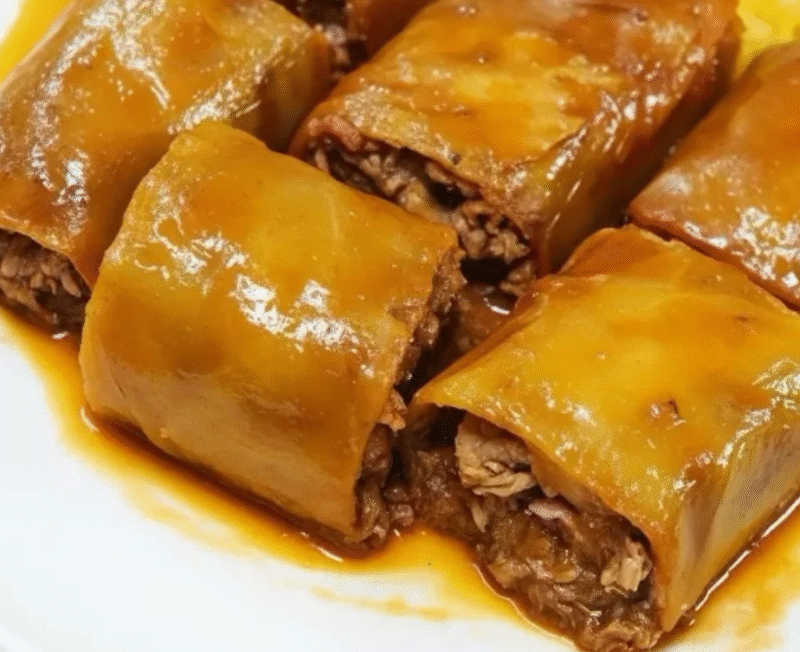Mexican Chile Colorado Tamales 🌶️
There’s something deeply satisfying about steaming tender masa wrapped around juicy beef simmered in smoky red chile sauce—these tamales bring warmth, tradition and bold flavour to the table. Whether you’re cooking for a special celebration, holiday gathering or simply craving authentic comfort food, these tamales deliver. And yes—they can be made ahead, frozen and reheated for maximum convenience.
Introduction: Why This Recipe Works
From the richly‑flavoured shredded beef infused with red chile sauce to the fluffy corn‑masa enveloping it, these tamales capture the heart of Mexican home‑cooking. The red chile (or “chile colorado”) sauce — made from dried guajillo and/or ancho chiles that are toasted, soaked and blended — provides a deep earthy heat and beautiful red colour that permeates both filling and masa. According to many traditional sources, the masa dough in authentic tamales is not just plain corn flour, but enriched by the cooking broth and sometimes the sauce itself. :contentReference[oaicite:0]{index=0}
These tamales are perfect because they bring:
- Deep, comforting flavour from slow‑cooked beef and chile sauce.
- A satisfying textural contrast between the soft, steamed masa and the savoury filling.
- Make‑ahead flexibility: you can prepare, freeze and steam when needed.
- Cultural resonance: tamales are often made for gatherings and celebrations, making this recipe feel special. :contentReference[oaicite:1]{index=1}
Table of Contents
- Why You Should Try This Recipe
- Storage Options
- Summary
- Equipment
- Ingredients
- For the Chile Colorado Sauce & Beef
- For the Masa
- To Assemble
- Instructions
- Notes
- Tips for Success
- Additional Tips & Variations
- Frequently Asked Questions (FAQ)
- Conclusion
Why You Should Try This Recipe
If you’ve ever wanted to experience authentic Mexican cuisine from your own kitchen, this recipe is the perfect place to start. It combines the art of slow‑cooked beef and tamale‑making tradition into one dish that’s flavorful, tender and steeped in heritage.
The red chile sauce, or “chile colorado,” is the heart of this dish — made from dried guajillo and ancho (or ancho/guajillo mix) chiles, toasted, soaked, blended and seasoned. It gives the dish its depth, and the colour of the masa often reflects the sauce. :contentReference[oaicite:2]{index=2}
Whether you’re preparing tamales for a family meal or a festive occasion, this recipe invites you to savour process, flavour and togetherness.
Storage Options
One of the greatest advantages of tamales is that they can be made ahead and stored or frozen for later use:
- Refrigerate cooked tamales: Once steamed, let them cool slightly, then store in an airtight container in the fridge for 3‑5 days. :contentReference[oaicite:3]{index=3}
- Freeze uncooked or cooked tamales: Many cooks assemble tamales, wrap them, then freeze before steaming — this helps retain freshness. One source suggests freezing for 4‑6 months. :contentReference[oaicite:4]{index=4}
- Reheating: From refrigerated: re‑steam ~20‑30 minutes until hot. From frozen: steam without thawing for ~30‑40 minutes (or more, depending on size). :contentReference[oaicite:5]{index=5}
Summary
In short: You’ll slow‑cook beef in a red chile sauce until tender; prepare a flavorful masa dough (often using some of the cooking broth or chile sauce for extra flavour); soak corn husks; assemble tamales by spreading masa, adding beef filling, folding; then steam until the masa is cooked through. The end result is tender, flavour‑rich tamales filled with smoky, deep red chile beef and wrapped in moist, fluffy masa. You’ll get both comfort and authenticity in each bite.
Equipment
- Large heavy pot or Dutch oven (for beef + sauce)
- Blender or food processor (for chile sauce)
- Large mixing bowl (for masa dough)
- Stand mixer or hand‑mixer (optional, to whip lard/masa) :contentReference[oaicite:6]{index=6}
- Large bowl for soaking corn husks
- Steaming pot or tamale steamer (with insert/steamer basket) or large pot with foil balls as alternative support :contentReference[oaicite:7]{index=7}
- Tongs or spatula (for handling hot tamales)
- Kitchen towels or heat‑proof cloth (to cover tamales while steaming)
Ingredients
Here are the general ingredient categories. Quantities will vary depending on how many tamales you make. You can scale accordingly.
For the Chile Colorado Sauce & Beef
- Beef chuck (or your preferred cut for shredding) – cut into chunks. :contentReference[oaicite:8]{index=8}
- Dried chiles (guajillo, ancho, or a mix) – stems removed, seeds/skins as desired.
- Onion, garlic, bay leaves, cumin, oregano, salt/pepper — for the sauce. :contentReference[oaicite:9]{index=9}
- Broth (beef or the liquid from the cooked beef) to use for sauce and part of the masa. :contentReference[oaicite:10]{index=10}
For the Masa
- Masa harina (corn flour for tamales) or prepared masa base.
- Lard or shortening (traditional and gives richer flavour) — many recipes say this is key. :contentReference[oaicite:11]{index=11}
- Baking powder and salt.
- Some of the beef broth + some of the red chile sauce (to flavour and colour the masa). :contentReference[oaicite:12]{index=12}
To Assemble
- Corn husks (dried, then soaked until softened).
- The beef filling (shredded beef mixed with chile sauce).
- Optional extras: olives, pimientos, potato slices, or other traditional additions. :contentReference[oaicite:13]{index=13}
Instructions
Here is a step‑by‑step method you can follow. Quantities and times may vary, so adjust based on your scale.
Step 1 – Cook the Beef
Place beef chunks in a large pot with enough water or broth to cover. Add onion, garlic, bay leaves, salt, pepper, cumin, oregano. Bring to a boil then reduce to a simmer and cook until beef is very tender and shreds easily. (Some sources suggest 2‑4 hours depending on size of meat). :contentReference[oaicite:14]{index=14}
Once cooked, remove beef and reserve broth. Shred the beef using forks. Set aside until you make the sauce and assemble tamales.
Step 2 – Prepare the Chile Colorado Sauce
Toast the dried chiles lightly (being careful not to burn). Remove stems/skins/seeds as desired. Place chiles in hot broth (from beef or fresh) and soak until softened (about 10‑20 minutes). :contentReference[oaicite:15]{index=15}
Blend the softened chiles with garlic, onion, seasonings and some of the soaking broth until smooth. Strain the sauce through a fine sieve to remove solids. Return sauce to pot, add beef broth as needed, and simmer for ~30 minutes or until flavour develops. Season with salt, pepper, vinegar or sugar as per taste. :contentReference[oaicite:16]{index=16}
Stir the shredded beef into the sauce (use enough sauce to moisten the meat but not drown it). Set aside until assembly.
Step 3 – Prepare the Corn Husks
Rinse the dried corn husks and soak them in warm water for ~30‑60 minutes until pliable. Pat dry and set aside. :contentReference[oaicite:17]{index=17}
Step 4 – Prepare the Masa Dough
In a mixing bowl, combine masa harina (or prepared masa base) with baking powder and salt. In a separate bowl, whip the lard (or shortening/alternative) until light and creamy. :contentReference[oaicite:18]{index=18}
Gradually add the beef broth and some of the chile sauce into the masa mixture, mixing (by hand, stand mixer or electric hand mixer) until the masa is light, pliable and spreadable (some tests say when it floats on water). :contentReference[oaicite:19]{index=19}
Step 5 – Assemble the Tamales
Place a soaked corn husk smooth‑side up in your palm. Spread ~2–3 tablespoons of masa (or per your size) onto the husk, leaving space at the bottom and top. Add ~1–2 tablespoons of shredded beef filling down the centre. Fold one side of the husk over the filling, then fold the other side, then fold up the bottom if needed. Repeat until all tamales are assembled. Some choose to tie the husk with a thin strip of husk. :contentReference[oaicite:20]{index=20}
Step 6 – Steam the Tamales
Set up your steamer pot: add water beneath the steamer basket (ensuring water does not touch the tamales). You may line the bottom with extra husks or aluminium foil balls if needed. Place the tamales upright (folded side down) in the steamer, cover with a damp towel, and steam on medium‑high heat for ~60‑90 minutes (depending on size/quantity) until the masa pulls away slightly from the husk and is cooked through. Check water periodically to avoid running dry. :contentReference[oaicite:21]{index=21}
Once done, remove from steamer, let rest 10‑15 minutes, then serve warm. If desired, top with extra chile sauce, salsa, or crema.
Notes
- Masa consistency is key: too dry and it will be crumbly; too wet and it may not steam properly.
- Measure how many husks you have to estimate how much masa and filling you’ll need.
- When freezing tamales: wrap individually or in small batches, freeze flat; when ready to cook, you can steam straight from frozen (add extra time) or thaw first for better texture. :contentReference[oaicite:22]{index=22}
- Depending on your region/tradition, you may adjust the number/type of chiles in the sauce for level of heat and smokiness.
- Leftover beef and sauce can be used for other Mexican dishes (enchiladas, burritos) so this makes great use of a large batch.
Tips for Success
Here are some chef‑style insights to elevate your tamale game:
- Use a high‑quality beef cut for shredding (such as chuck) so you get good flavour and texture when cooked. Chef Bobby Flay would emphasise good ingredient quality as the basis of success.
- When toasting chiles: be light‑handed — burnt chiles become bitter, so toast 10‑20 seconds per side until fragrant. Then soak immediately in hot broth.
- Test your masa: Some recipes describe a “float test” — take a small piece of masa and drop it in water; if it floats, it’s light enough. If not, keep mixing/whipping. :contentReference[oaicite:23]{index=23}
- Don’t overcrowd the steamer. Leave space between tamales so steam circulates well and they cook evenly.
- After steaming, let tamales rest a short while before serving so steam stops and they firm up slightly — easier to unwrap and serve.
- For best texture, keep tamales wrapped in a warm towel or cover immediately so they don’t cool and dry out before serving.
Additional Tips & Variations
- Alternate fillings: While beef in red chile is classic, you can adapt this to pork, chicken or vegetarian fillings (beans, mushrooms, squash) while still using the red chile sauce base. :contentReference[oaicite:24]{index=24}
- Spice level variations: Use more or fewer chiles, include chipotle or arbol chiles for heat, or add smoked paprika for a smoky twist.
- Masa flavour tweaks: Use part of the chilli sauce in the masa for added colour and flavour (common in many recipes). You can also use chicken broth instead of beef for lighter version.
- Make‑ahead strategy: Prepare sauce and beef ahead (1‑2 days), prepare husks and masa day before, then assemble and steam on serving day. This spreads the work out and makes for smoother cooking on event day.
- Serving ideas: Serve tamales with extra chile sauce, a fresh salsa (verde or roja), crema or sour cream, chopped fresh herbs (cilantro), and pickled onions or radishes on the side.
Frequently Asked Questions (FAQ)
- What is “chile colorado”?
“Chile colorado” literally means “red chile.” In this context it refers to a sauce made from dried red chiles (often guajillo, ancho) that is toasted, soaked and pureed to make a rich, red sauce. It’s a classic base in many Mexican dishes including tamales. :contentReference[oaicite:25]{index=25} - Do I need lard in the masa?
Traditional recipes call for lard because it gives the masa a richer flavour and better texture. Some modern versions use vegetable shortening or oil, but the result may be slightly different. :contentReference[oaicite:26]{index=26} - Can I make tamales ahead of time and freeze them?
Yes — you can assemble tamales ahead and freeze either raw (uncooked) or after steaming. When ready, steam frozen tamales (no need to thaw) but add extra cook time. Many sources suggest 4‑6 months freezer life. :contentReference[oaicite:27]{index=27} - How do I know if the tamales are cooked through?
Check: the masa should pull away from the husks easily, be firm (not gooey) and the filling hot. Some recipes suggest testing one large tamale mid‑batch. :contentReference[oaicite:28]{index=28} - My masa seems too wet or too dry — what do I do?
If it’s too wet the tamales may fall apart; if too dry they’ll be crumbly. Adjust by adding a little more broth or lard (for moisture) or a little more masa harina. A good test is the “float test” for masa. :contentReference[oaicite:29]{index=29} - Can I use store‑bought masa dough instead of making it from scratch?
You can, especially if you’re short on time — many Mexican markets carry prepared tamale masa. However, making your own allows you to flavour it with the chile sauce and broth for fuller flavour. :contentReference[oaicite:30]{index=30} - How many tamales will this recipe make?
Depends on how big you make them and how much masa/filling you prepare. Some sources list small batches (~30–35 tamales) and larger batches (~48 or more). :contentReference[oaicite:31]{index=31} - What cut of beef is best?
Choose a cut that shreds easily after cooking (beef chuck roast, brisket, or similar) and has good flavour. The slow‑cooking and sauce will do the rest. :contentReference[oaicite:32]{index=32} - How do I adjust for spice levels?
You can adjust by using fewer hot chiles or removing seeds, or using milder chiles. Conversely, you can add chipotle, arbol or chilli flakes to increase heat. Adjust to taste when blending your sauce. - What should I serve with these tamales?
Great accompaniments include: a fresh green salad with lime vinaigrette, refried beans, Mexican rice, salsa verde or roja, crema/sour cream, pickled onions or radishes. For brunch versions, you can top with a fried egg.
Conclusion
Tamales like these — filled with shredded beef in chile colorado sauce and wrapped in soft, steamed masa — are both comforting and celebratory. They bring together flavour, tradition and community in one delicious bundle. With a little planning (and time), you can make a batch ahead, freeze for later, and delight friends and family when it’s time to serve.
Remember the keys: a deeply‑flavored red chile sauce, tender shredded beef, a well‑prepared masa dough, proper steaming, and some love in the assembly. Ask yourself: Are the chiles toasted not burnt? Is the masa light and spreadable? Are the corn husks soaked and pliable? Did you test a tamale for doneness before serving? If yes, you’re on the right track.
Enjoy every moment of making them. The process is as rewarding as the result — and the reward is delicious. Buen provecho! 🇲🇽






